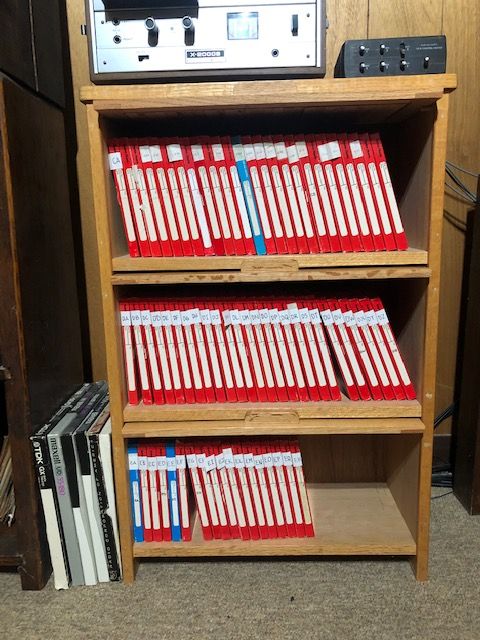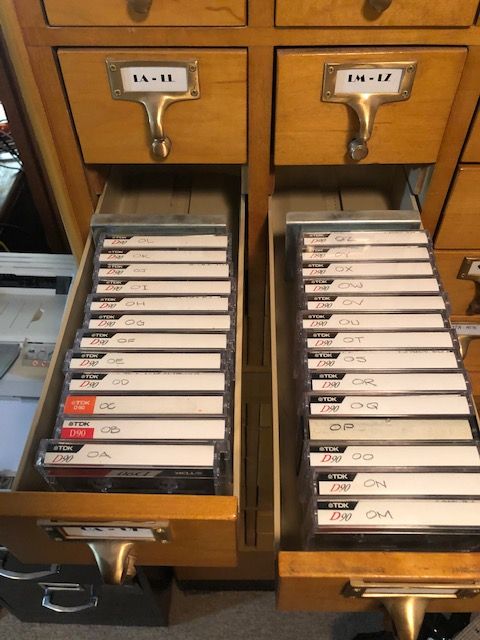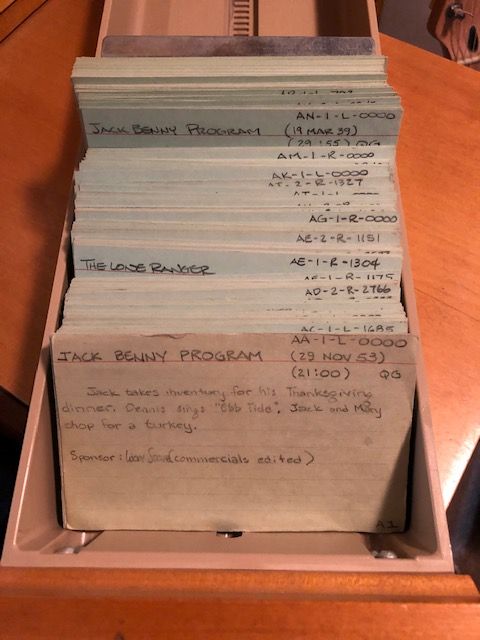Through the Years
- What I Was Listening To
- The Radios
- Old Time Radio - Part 1
- Old Time Radio - Part 2
- New Time Radio - Part 1
- New Time Radio - Part 2
Links
Old Time Radio - Part 1
 Being raised by parents who'd grown up on radio, it's influences were there indirectly through references and catch-phrases. While I didn't hear the shows live myself, I knew about Fibber McGee's closet, Red Skelton's Junior "the mean widdle kid," and who Mortimer Snerd was because my parents mentioned them over time. I was certainly aware that there was something before television and knew that many TV shows and actors came from radio, such as Jack Benny, Burns and Allen, Bob Hope, Gunsmoke, the Lone Ranger, and the Green Hornet. I don't remember our family having a television set before 1960 when we moved to Hawaii and since I was about 8-years old so I may have heard some Old Time Radio shows but was was too young to remember them.
Being raised by parents who'd grown up on radio, it's influences were there indirectly through references and catch-phrases. While I didn't hear the shows live myself, I knew about Fibber McGee's closet, Red Skelton's Junior "the mean widdle kid," and who Mortimer Snerd was because my parents mentioned them over time. I was certainly aware that there was something before television and knew that many TV shows and actors came from radio, such as Jack Benny, Burns and Allen, Bob Hope, Gunsmoke, the Lone Ranger, and the Green Hornet. I don't remember our family having a television set before 1960 when we moved to Hawaii and since I was about 8-years old so I may have heard some Old Time Radio shows but was was too young to remember them.
This passion, yes, a passion, for Old Time Radio (OTR) shows goes back to around 1967 when a Los Angeles radio station started playing The Shadow, The Green Hornet, and the Adventures of Sherlock Holmes on Sunday afternoons. For whatever reason I was hooked and I could be found in front of the family's Silvertone console hi-fi system every week to hear them. While it certainly had something to do with the stories and the acting, it was more the images that formed in my mind, illustrating the narrative the way books had done for me previously.
The Collecting Begins
Sometime around 1970 I started taping these shows, partially to time-shift them, but I soon found that I enjoyed hearing them again and again, something we didn't like with television reruns. On Saturday mornings I could pick up a couple episodes of "The Shadow" from KPPC.
Listen to the end of the The Shadow with the KPPC commercials and the DJ introducing the next show, from the very early 1970s: Click Here - (3:30)
In 1971 and 1972, Harvey Tow, in his personna as "Cousin Zino" presented OTR shows at 9pm on Sundays on KPPC. I dug through my old cassettes and found a few I recorded from that time. Here's a sample:
Listen to the end of the The Adventures of Sherlock Holmes with Cousin Zino announcing on KPPC from the very early 1970s: Click Here - (1:48)
In 1971 and 1972, KPPC had Old Time Radio marathons where Harvey Tow hosted 24-hours of nothing but back to back vintage shows over the 4th of July weekends. I fired up my Panasonic RS-760S and recorded as much of it as I could.
Here's Harvey in his Cousin Zino personna during the marathon: Click Here - (1:23)
On Sunday evenings, KRLA played the syndicated "Same Time, Same Station" which usually featured an interview with someone from the Golden Age of Radio with excerpts of their show and, usually, a complete episode. I even found OTR shows on LP records at our library. I would mention this interest to friends of mine and they were polite although they thought it was a bit unusual. I really didn't know anyone else who found these programs as attractive as I did so I just collected and listened on my own.
In 1972 I found myself in the army had no contact with OTR until 1974 when I was stationed in Europe. Armed Forces Radio played some of these programs in the evenings and I listened while I was pulling guard duty at a misslie site. I don't remember what shows they featured but it seems there were comedy shows and a mystery or two on those evenings.
I returned stateside in the end of 1975 and within a few years I found OTR on the left end of the FM radio dial, played on NPR affiliates by local collectors. On KPCC, originally on Monday evenings, I listened to the shows hosted by John and Larry Gassman. Of course I recorded these broadcasts and added the individual shows to my collection. Here's an excerpt of one of those shows with John and Larry chatting about programming:
Excerpt from "Same Time Same Station" with John and Larry Gassman on KPCC - from the 1980s - (7:53)
On Sundays I would first tune in to KCSN for a show hosted by Barbara Sunday and Bobb Lynes which broadcast from California State University, Northridge. Since I was in Long Beach and Northridge was about 60 miles to the northwest on the other side of the Hollywood Hills, their signal was rather week. To address this I bought and installed a rotator for the FM antenna on my roof. I could spin the antenna around and point it right at Northridge to get a good signal. Here is an excerpt from one of those shows:
Excerpt from "Don't Touch that Dial" with Barbara Sunday and Bobb Lynes - from October 1989 - (4:08)
Bobb then went to Santa Monica where he hosted his own show on KCRW. The first hour was usually kid's shows and serials, followed by two hours of great OTR. I recorded years of this show and added many new aarrivals to my collection. Here is the introduction to Bobb's show when he replays his old introduction theme from 1982:
Excerpt from "The Old Time Radio Show" with Bobb Lynes - from May 1991 - (5:48)
And, it should be mentioned that KNX of Los Angeles, played OTR every evening at 9pm for many years. Although these shows where hacked up to allow for the insertion of contemporary commercials, I did record some of them.
 Since there was so much OTR on Sundays and Mondays, I would record it on a 6-hour tape using my Tandberg TD20A SE. Then, during the week, I would play those back and copy the shows I wanted using my Akai 202D-SS as the recorder. I liked thin tape that let me save 3 hours per side on a 7" reel so, for the most part, I used Realistic Low Noise 3600 tapes which I bought from Radio Shack for about $8/reel. Some may suggest that the quality of that tape leaves something to be desired but I wasnt't recording hi-fi with these shows and they sounded as good as they did coming over the FM airwaves when I listened to them on playback. Now, about 36 years later, they have held up well without any of the problems that some older tapes have had, such as sticky-shed-syndrome. Over the years I used over 120 reels of that tape.
Since there was so much OTR on Sundays and Mondays, I would record it on a 6-hour tape using my Tandberg TD20A SE. Then, during the week, I would play those back and copy the shows I wanted using my Akai 202D-SS as the recorder. I liked thin tape that let me save 3 hours per side on a 7" reel so, for the most part, I used Realistic Low Noise 3600 tapes which I bought from Radio Shack for about $8/reel. Some may suggest that the quality of that tape leaves something to be desired but I wasnt't recording hi-fi with these shows and they sounded as good as they did coming over the FM airwaves when I listened to them on playback. Now, about 36 years later, they have held up well without any of the problems that some older tapes have had, such as sticky-shed-syndrome. Over the years I used over 120 reels of that tape.
 In January of 1989 I made the switch to saving these shows on cassette. The reason was that the reel tapes where getting difficult to find, sometimes having to go to several stores before finding it in stock. Another reason was that the cassettes could readily be used in the car. I was commuting many miles in Sounthern California at the time and a handful of cassettes containing OTR made those miles slip by. I used, almost exclusively, TDK D90 cassettes. Again, the quality of the tape fit the quality of the shows I was recording. By the time I moved to Montana in 1991 and lost my source of OTR, I'd used about 400 of those tapes.
In January of 1989 I made the switch to saving these shows on cassette. The reason was that the reel tapes where getting difficult to find, sometimes having to go to several stores before finding it in stock. Another reason was that the cassettes could readily be used in the car. I was commuting many miles in Sounthern California at the time and a handful of cassettes containing OTR made those miles slip by. I used, almost exclusively, TDK D90 cassettes. Again, the quality of the tape fit the quality of the shows I was recording. By the time I moved to Montana in 1991 and lost my source of OTR, I'd used about 400 of those tapes.
Connecting to OTR Online
My collecting whent on a hiatus for a few years until I became active online. At first I had Prodigy service, which was a competitor to AOL, and it had an OTR discussion forum. By 1996 I had World Wide Web access and, within a few days of getting it, I figured out how to write in HTML and set up my own web site that featured, among other things, Old Time Radio. I also joined an OTR mailing list that hosted discussion on the hobby. Through that list, and my web site, I met a few others who were intersted in trading programs. We'd make arrangements over email and then send cassettes to one another. If someone wanted something I had and they had nothing to trade I'd simply ask for blank cassettes in return which were always useful.
About this time my collection had grown to about 3,000 shows and I had already started to archive them in the new MP3 format. I was contacted by another collector who asked if I was intersted in joining a trading group. Sure, why not? The group was free to join and was made up of about a dozen of us scattered around the country with one in Canada and one in England. We operated solely via email and US Mail. At the time, we would send our volunteer librarian our shows as MP3 files on burned Compact Discs. He'd bundle a bunch together, perhaps 6 discs at a time, and then send them to the first person on the list. They would copy the collection and then send them on to the next one on the list. We kept at this for quite a few years until we'd pretty much exhausted our collections and other sources. By that time I had somewhere north of 60,000 shows in the collection.
There were other sources of shows online. USENET was always a good source as were various web site, although the quality of file compression could make some shows unlistenable, especially those using the Real Audio format. Then we had the issue of sites trying to monetize what they had by charging for downloads. In about 2000, that led to the time when a company who claimed they owned the copyright on most shows from that era sent out cease and desist notices to quite a few web sites which caused many/most sites to go offline. I never received one of those notices and kept my site running though those dark days. Of course, I wasn't charging for shows and I wasn't providing shows that were clearly still under copyright such as The Lone Ranger and The Shadow.
Keeping Organized
 Keeping track of a collection of any kind is just part of the hobby. My first attempt was to just write things down in a spiral notebook and write the reel number at the top of the page. My second catalog, started in the mid-1970s, was kept on index cards, green ones, on which I would write down the important information about the show: show name, title, original broadcast date, description of what takes places, the cast, and where in the collection it can be found. This worked quite well for a time but searching for a title, or anything else, was tedious. Since I had learned how to program my Apple ][ computer, which now had dual floppy disc drives for data storage, I thought it was time I wrote an OTR Catalog program. I did and it worked pretty well but I never did get everything typed into it and it languished.
Keeping track of a collection of any kind is just part of the hobby. My first attempt was to just write things down in a spiral notebook and write the reel number at the top of the page. My second catalog, started in the mid-1970s, was kept on index cards, green ones, on which I would write down the important information about the show: show name, title, original broadcast date, description of what takes places, the cast, and where in the collection it can be found. This worked quite well for a time but searching for a title, or anything else, was tedious. Since I had learned how to program my Apple ][ computer, which now had dual floppy disc drives for data storage, I thought it was time I wrote an OTR Catalog program. I did and it worked pretty well but I never did get everything typed into it and it languished.
In the later 1980s I had upgraded to a PC-type computer and had a copy of dBase. I created a database for OTR and spent the time to enter the shows I had into it. Searching was now a fast and easy task as was sorting by show or by date. This is how I kept track of the collection until sometime in the later 1990s when I had upgraded to a better computer and decided that I just wanted it all in a spreadsheet. I was able to export from dBase to Excel without a problem and the spreadsheet became my search and sort tool for a long while.
In the meantime I was getting all these shows from the trading group and they were coming in faster than I could get them entered into the spreadsheet. So, for a while, the collection grew and I had to rely on mememory as to what show might be on what disc in the collection. That really didn't work that well. By this time I'd become adept at programming in the PHP language and using a web based database, MySQL. I decided to, again, create a new catalog and import the old one into it. The advantage this time is that I could run this on a web server on my home network and access it with any device on that network. It took a while to get the software written and debugged but in 2015 I had it working well enough to start entering data. I first imported the old spreadsheet and then tackled the files on all those discs.
I would first copy the the disc to my compueter and then write a utility program that would read the filenames and parse them into show name, title, and dates. While this sounds like it was automated, with so many variations on how file names were written, it was still labor intensive. After a few months I finally got everything entered and now I have a fully searchable database with the added feature that, since I have also copied all the OTR files to my hardrive, I can play the shows directly through the browser.
I go into much more detail on this web-based database on this page of my OTR web site:
The OTR Database Project
While I already had my first 3,000 shows in the database (they were the ones from the spreadsheet), the shows were still on tape so the next job was to digitize all them. This took a while but I eventually got all of them coverted to MP3 so now the entire collection is digital and resides on a single external hardrive.
Click on an image to enlarge it.
Updated January 2021.